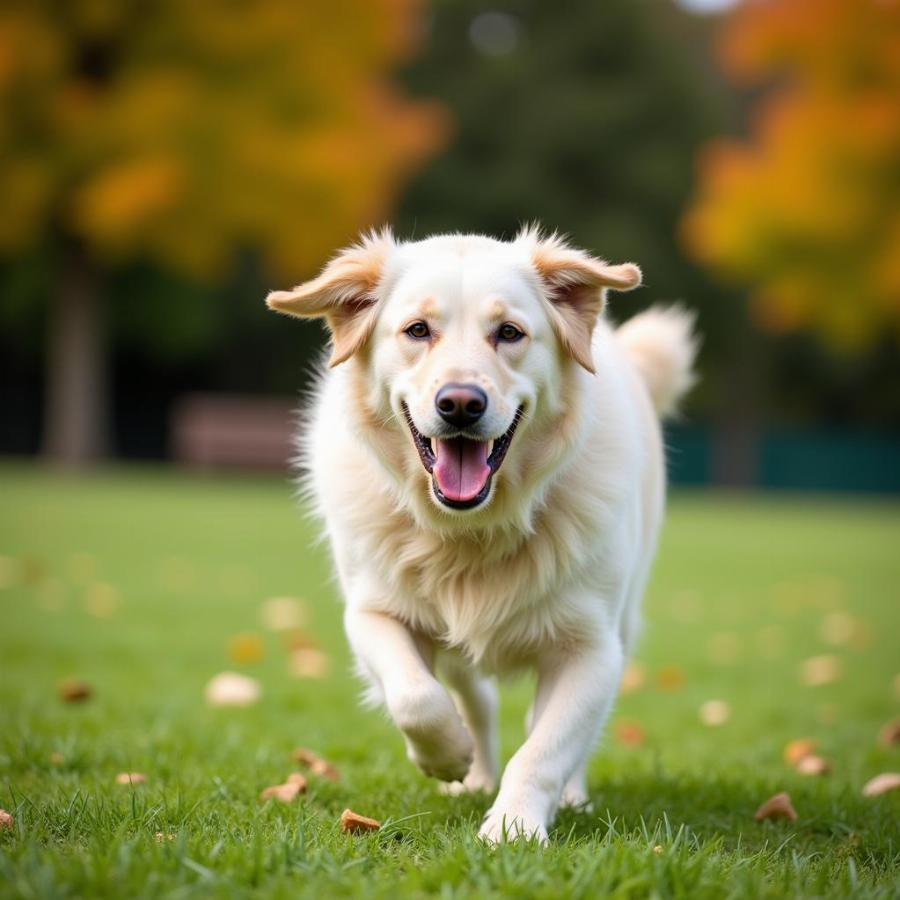The Labrador Pyrenees mix, often referred to as the Labrenees, is a fascinating blend of two beloved breeds: the Labrador Retriever and the Great Pyrenees. This mix brings together the playful energy of the Lab with the gentle giant nature of the Pyrenees, resulting in a unique companion. Are you considering welcoming a Labrenees into your home? Let’s delve into the key aspects of owning this captivating crossbreed.
Temperament and Personality of a Labrenees
What can you expect from a Labrenees’s personality? This mix often inherits the best of both worlds: the Lab’s friendly, outgoing nature and the Pyrenees’ calm, protective instincts. They are typically loyal, affectionate, and gentle with family members, making them wonderful companions for children. However, their protective instincts can also make them wary of strangers, so early socialization is crucial. This involves exposing them to various people, places, and sounds from a young age to help them develop into well-adjusted adults. Remember, a well-socialized Labrenees is a happy Labrenees!
Is a Labrenees Right for Me?
Choosing the right dog breed is a big decision. Consider your lifestyle and living situation. Labrenees are large dogs with moderate to high energy levels. They thrive in homes with ample space, preferably a fenced yard where they can roam and play. Their thick double coat requires regular grooming, especially during shedding season. If you’re prepared to provide the necessary exercise, training, and grooming, a Labrenees can be a loving and rewarding addition to your family. Check out our article on dogs for black people for more breed considerations.
 Labrador Pyrenees mix playing fetch in a park
Labrador Pyrenees mix playing fetch in a park
Training and Exercise Needs of a Labrador Pyrenees Dog
How much exercise does a Labrenees need? Given their energetic nature, Labrenees benefit from daily physical activity. This could include brisk walks, runs, hikes, or playtime in a secure area. Mental stimulation is equally important. Puzzle toys, training sessions, and interactive games can help keep their minds engaged and prevent boredom.
What are the Best Training Methods for a Labrenees?
Positive reinforcement techniques, such as rewarding good behavior with treats and praise, are generally effective with Labrenees. They are intelligent dogs eager to please their owners. Consistency and patience are key to successful training. Start training early and establish clear boundaries. Early socialization is especially crucial for this breed to ensure they develop into well-adjusted adults. For more information on large breed training, take a look at our article on lab newfoundland mix dogs.
Grooming and Health Considerations
What kind of grooming does a Labrador Pyrenees dog require? The Labrenees has a dense double coat that requires regular brushing to prevent matting and tangles. They shed seasonally, so be prepared for increased grooming during those times. Regular bathing is also important to keep their coat clean and healthy.
Are Labrenees Prone to Any Specific Health Issues?
While generally healthy, Labrenees can be susceptible to certain health conditions common to both parent breeds, such as hip and elbow dysplasia, bloat, and certain eye problems. Regular veterinary checkups and a healthy diet can help mitigate these risks.
Living with a Labrenees: What to Expect
Bringing a Labrenees into your life can be a truly enriching experience. Their affectionate nature and playful spirit make them wonderful family companions. They are often eager to please and enjoy being involved in family activities. However, their size and protective instincts mean they require consistent training and socialization from a young age.
Is a Labrenees a Good Family Dog?
Labrenees can be excellent family dogs, especially in homes with older children. Their gentle nature and love for play make them great companions for kids. However, it’s important to supervise interactions between dogs and young children to ensure both the dog and the child are safe and comfortable. For families considering other large breeds, see our article on the newfoundland dog and labrador mix.
Conclusion
The Labrador Pyrenees dog, a captivating blend of Labrador Retriever and Great Pyrenees, offers a unique combination of playful energy and gentle protectiveness. With proper training, socialization, and care, a Labrenees can be a loyal and loving companion for years to come. Remember, understanding the breed’s specific needs is crucial to ensuring a harmonious relationship. Are you ready to welcome a Labrenees into your home?
FAQs
- How big do Labrenees get? Labrenees typically range from 24 to 30 inches in height and can weigh between 60 and 100 pounds.
- Do Labrenees bark a lot? They can bark to alert their family to anything unusual, but excessive barking is not typically a problem with proper training.
- Are Labrenees good with other pets? With early socialization, they can generally get along well with other pets in the household.
- How much do Labrenees shed? They have a thick double coat and shed seasonally, requiring regular grooming.
- How long do Labrenees live? Their lifespan is typically between 10 and 12 years.
- Are Labrenees hypoallergenic? No, they are not hypoallergenic.
- Do Labrenees need a lot of space? They are large dogs and thrive in homes with a fenced yard where they can exercise.
Have you ever thought about a hot dog big breed? You might want to check that out! Or maybe you are interested in the unique spy family dog?
Beaut Dogs is your go-to resource for all things related to owning and caring for beautiful dog breeds. We provide expert advice, helpful tips, and in-depth information to help you navigate the wonderful world of canine companionship. For further assistance, please contact us via Email: [email protected] to get detailed and accurate answers from Beaut Dogs. We’re here to support you every step of the way.